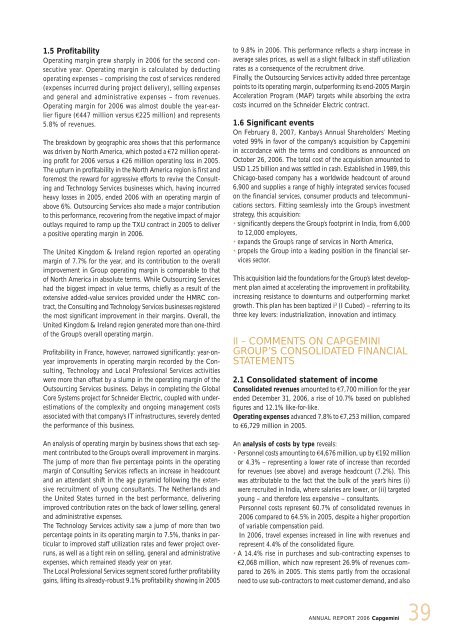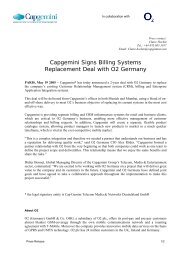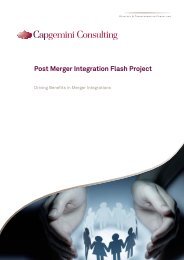Create successful ePaper yourself
Turn your PDF publications into a flip-book with our unique Google optimized e-Paper software.
1.5 Profitability<br />
Operating margin grew sharply in 2006 for the second consecutive<br />
year. Operating margin is calculated by deducting<br />
operating expenses – comprising the cost of services rendered<br />
(expenses incurred during project delivery), selling expenses<br />
and general and administrative expenses – from revenues.<br />
Operating margin for 2006 was almost double the year-earlier<br />
figure (€447 million versus €225 million) and represents<br />
5.8% of revenues.<br />
The breakdown by geographic area shows that this performance<br />
was driven by North America, which posted a €72 million operating<br />
profit for 2006 versus a €26 million operating loss in 2005.<br />
The upturn in profitability in the North America region is first and<br />
foremost the reward for aggressive efforts to revive the Consulting<br />
and Technology Services businesses which, having incurred<br />
heavy losses in 2005, ended 2006 with an operating margin of<br />
above 6%. Outsourcing Services also made a major contribution<br />
to this performance, recovering from the negative impact of major<br />
outlays required to ramp up the TXU contract in 2005 to deliver<br />
a positive operating margin in 2006.<br />
The United Kingdom & Ireland region reported an operating<br />
margin of 7.7% for the year, and its contribution to the overall<br />
improvement in Group operating margin is comparable to that<br />
of North America in absolute terms. While Outsourcing Services<br />
had the biggest impact in value terms, chiefly as a result of the<br />
extensive added-value services provided under the HMRC contract,<br />
the Consulting and Technology Services businesses registered<br />
the most significant improvement in their margins. Overall, the<br />
United Kingdom & Ireland region generated more than one-third<br />
of the Group’s overall operating margin.<br />
Profitability in France, however, narrowed significantly: year-onyear<br />
improvements in operating margin recorded by the Consulting,<br />
Technology and Local Professional Services activities<br />
were more than offset by a slump in the operating margin of the<br />
Outsourcing Services business. Delays in completing the Global<br />
Core Systems project for Schneider Electric, coupled with underestimations<br />
of the complexity and ongoing management costs<br />
associated with that company’s IT infrastructures, severely dented<br />
the performance of this business.<br />
An analysis of operating margin by business shows that each segment<br />
contributed to the Group’s overall improvement in margins.<br />
The jump of more than five percentage points in the operating<br />
margin of Consulting Services reflects an increase in headcount<br />
and an attendant shift in the age pyramid following the extensive<br />
recruitment of young consultants. The Netherlands and<br />
the United States turned in the best performance, delivering<br />
improved contribution rates on the back of lower selling, general<br />
and administrative expenses.<br />
The Technology Services activity saw a jump of more than two<br />
percentage points in its operating margin to 7.5%, thanks in particular<br />
to improved staff utilization rates and fewer project overruns,<br />
as well as a tight rein on selling, general and administrative<br />
expenses, which remained steady year on year.<br />
The Local Professional Services segment scored further profitability<br />
gains, lifting its already-robust 9.1% profitability showing in 2005<br />
to 9.8% in 2006. This performance reflects a sharp increase in<br />
average sales prices, as well as a slight fallback in staff utilization<br />
rates as a consequence of the recruitment drive.<br />
Finally, the Outsourcing Services activity added three percentage<br />
points to its operating margin, outperforming its end-2005 Margin<br />
Acceleration Program (MAP) targets while absorbing the extra<br />
costs incurred on the Schneider Electric contract.<br />
1.6 Significant events<br />
On February 8, 2007, Kanbay’s Annual Shareholders’ Meeting<br />
voted 99% in favor of the company’s acquisition by <strong>Capgemini</strong><br />
in accordance with the terms and conditions as announced on<br />
October 26, 2006. The total cost of the acquisition amounted to<br />
USD 1.25 billion and was settled in cash. Established in 1989, this<br />
Chicago-based company has a worldwide headcount of around<br />
6,900 and supplies a range of highly integrated services focused<br />
on the financial services, consumer products and telecommunications<br />
sectors. Fitting seamlessly into the Group’s investment<br />
strategy, this acquisition:<br />
significantly deepens the Group’s footprint in India, from 6,000<br />
to 12,000 employees,<br />
expands the Group’s range of services in North America,<br />
propels the Group into a leading position in the financial services<br />
sector.<br />
This acquisition laid the foundations for the Group’s latest development<br />
plan aimed at accelerating the improvement in profitability,<br />
increasing resistance to downturns and outperforming market<br />
growth. This plan has been baptized i 3 (I Cubed) – referring to its<br />
three key levers: industrialization, innovation and intimacy.<br />
II – COMMENTS ON CAPGEMINI<br />
GROUP’S CONSOLIDATED FINANCIAL<br />
STATEMENTS<br />
2.1 Consolidated statement of income<br />
Consolidated revenues amounted to €7,700 million for the year<br />
ended December 31, 2006, a rise of 10.7% based on published<br />
figures and 12.1% like-for-like.<br />
Operating expenses advanced 7.8% to €7,253 million, compared<br />
to €6,729 million in 2005.<br />
An analysis of costs by type reveals:<br />
Personnel costs amounting to €4,676 million, up by €192 million<br />
or 4.3% – representing a lower rate of increase than recorded<br />
for revenues (see above) and average headcount (7.2%). This<br />
was attributable to the fact that the bulk of the year’s hires (i)<br />
were recruited in India, where salaries are lower, or (ii) targeted<br />
young – and therefore less expensive – consultants.<br />
Personnel costs represent 60.7% of consolidated revenues in<br />
2006 compared to 64.5% in 2005, despite a higher proportion<br />
of variable compensation paid.<br />
In 2006, travel expenses increased in line with revenues and<br />
represent 4.4% of the consolidated figure.<br />
A 14.4% rise in purchases and sub-contracting expenses to<br />
€2,068 million, which now represent 26.9% of revenues compared<br />
to 26% in 2005. This stems partly from the occasional<br />
need to use sub-contractors to meet customer demand, and also<br />
ANNUAL REPORT 2006 <strong>Capgemini</strong><br />
39















